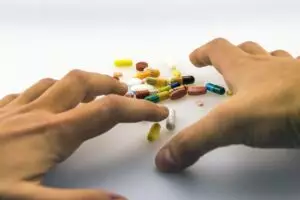For many people it starts innocently enough: an injury or chronic pain. So how does this turn into an addiction?
Prescription to Addiction
Let’s meet our hypothetical friend Terry. Terry could be any gender, any ethnicity, and of any social class–though there are definitively certain groups affected by the opioid crisis more than others. Terry hurts their back while lifting something at work and goes to the doctor. The doctor prescribes some ibuprofen but the pain remains. This time, the doctor gives Terry a prescription for Oxycodone.
The Oxycodone works well for Terry and they start to feel better. They go back to work and life begins to return to normal. But Terry begins to notice that the pain returns when they’ve not had the medicine so they make sure to always take it. In the background, Terry’s mind and body is developing a tolerance to the medicine. Terry begins to need to take more than the prescribed dose to compensate for this tolerance.
 Terry’s doctor may continue prescribing Oxycodone or may at this point say it’s not safe to continue, but at this point, Terry has become addicted. The pain is extraordinary and Terry starts to go through withdrawal symptoms whenever they don’t have any oxycodone. So Terry searches for an alternate source and starts buying their fix from a dealer, possibly even transitioning into the stronger heroin.
Terry’s doctor may continue prescribing Oxycodone or may at this point say it’s not safe to continue, but at this point, Terry has become addicted. The pain is extraordinary and Terry starts to go through withdrawal symptoms whenever they don’t have any oxycodone. So Terry searches for an alternate source and starts buying their fix from a dealer, possibly even transitioning into the stronger heroin.
What Can Be Done
Terry’s story, though hypothetical, happens to a lot of people. Many other people use the medicine as prescribed and never have a problem. It is important to approach the idea of addiction carefully and realize everyone’s story is different. Carefully discuss family and personal history of addiction with your doctor prior to taking an opiate to make the best informed decision. At the first sign of addiction, it is critical to talk to your doctor to learn how to transition off the medicine and into a safer way to manage your pain. For more information about substance abuse treatment in Florida, call us at (855) 425-4846.

